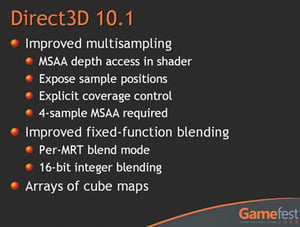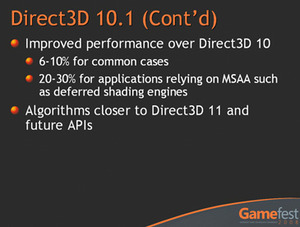cybercore
New Member
- Joined
- Jul 7, 2009
- Messages
- 15,641
- Thread Author
- #1
DirectX 10 vs Directx 10.1
Link Removed - Invalid URL
DirectX 10.1:
- improved access to shader resources - In particular, this involves better control when reading back samples from multi-sample anti-aliasing. In conjunction with this, the ability to create customised downsampling filters will be available in DirectX 10.1
- the introduction of 32-bit floating-point filtering over the 16-bit filtering
- floating point blending - New formats for render targets which support blending will be available in this iteration of the API, and render targets can now be blended independently of one another
- cube mapping, gets its own changes which should help with performance, in the form of the ability to use an indexable array for handling cube maps
- DirectX 10.1 will allow for higher performance in multi-core systems, which is certainly good news for the ever growing numbers of dual-core users out there. The number of calls to the API when drawing and rendering reflections and refractions (two commonly used features in modern game titles) has been reduced in Direct3D 10.1, which should also make for some rather nice performance boosts
- DirectX 10.1 give the application control over the pixel coverage mask, a mask which is used to help to quickly approximate sampling for an area of pixels. This in particular should prove to be a boon when anti-aliasing particles, vegetation, scenes with motion blur and the like. All of this additional control handed to the application could allow for anti-aliasing to be used much more wisely and effectively, and controlled by game developers themselves, rather than the current 'all or nothing' implementation available, which basically amounts to a simple on-off switch
Link Removed - Invalid URL
Link Removed - Invalid URL
DirectX 10.1:
- improved access to shader resources - In particular, this involves better control when reading back samples from multi-sample anti-aliasing. In conjunction with this, the ability to create customised downsampling filters will be available in DirectX 10.1
- the introduction of 32-bit floating-point filtering over the 16-bit filtering
- floating point blending - New formats for render targets which support blending will be available in this iteration of the API, and render targets can now be blended independently of one another
- cube mapping, gets its own changes which should help with performance, in the form of the ability to use an indexable array for handling cube maps
- DirectX 10.1 will allow for higher performance in multi-core systems, which is certainly good news for the ever growing numbers of dual-core users out there. The number of calls to the API when drawing and rendering reflections and refractions (two commonly used features in modern game titles) has been reduced in Direct3D 10.1, which should also make for some rather nice performance boosts
- DirectX 10.1 give the application control over the pixel coverage mask, a mask which is used to help to quickly approximate sampling for an area of pixels. This in particular should prove to be a boon when anti-aliasing particles, vegetation, scenes with motion blur and the like. All of this additional control handed to the application could allow for anti-aliasing to be used much more wisely and effectively, and controlled by game developers themselves, rather than the current 'all or nothing' implementation available, which basically amounts to a simple on-off switch
Link Removed - Invalid URL

